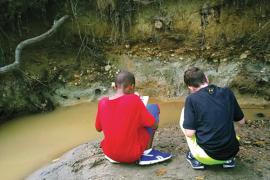No camp is immune to sneaky food raids. Over the years many camp directors have reported food incidents involving bears, strangers break-ing into kitchens, and, most often, camp staff. Tales of food raids are often legendary among staff, and they provide fodder for staff campfire stories and unspoken challenges that crop up each summer. Making the call about how to approach each food service-related issue falls to the camp director. Generally, the most effective means of protecting and maintaining a high level of professional, quality food production — within budget — is knowledge and training.
One of the first orders of business during staff orientation and training needs to be addressing the importance of employees understanding and embracing their personal responsibility in the overall camp operation. Food service staff members must have clearly outlined expectations regarding the consump-tion of camp food that is not served on dining room tables. Staff (food service and non-food service) often cook meals, snacks, and midnight party food without management knowing; this can completely skew the food service budget, cause food shortages for an upcoming meal, and cause misgivings about those entrusted with keys or responsibility.
Why Is Staff Food Consumption an Issue?
- A staff member declines the camp meal offered during his or her meal break, saying, “I’m not really hungry right now. I’ll make a little something for myself later.”
- Pantry inventory numbers are mysteri-ously off from what is posted on the door.
- Pantry foods commonly missing are potato and corn chips, chocolate chips, granola bars, marshmallows, chocolate bars, graham crackers, salsa, and ice cream toppings.
- Refrigerator items commonly missing are cheddar cheese and sour cream.
- Freezer items commonly missing include frozen cookie dough and ice cream.
In an interesting survey conducted recently with camp directors and food service directors, a plethora of ingenious, devious, and admittedly comical tactics for gaining access to camp food storage facilities during off hours were shared. One camp had a partial wall dividing the space between the camp store and the pack-out gear and supplies. The dividing wall was 12 inches from the ceiling. In all fairness to the camp director who had the wall installed, those 12 inches probably seemed impenetrable. Apparently not. The staff found the smallest and skinniest person in the snack food heist gang who then shimmied his way over the wall to snag candy and other snacks, and the crew slipped out under the cover of darkness.
Another food service director shared an incident involving leftover spaghetti sauce with meatballs. The leftover food had not been served to campers, so the food service director painstakingly followed the ServSafe-required food safety measure of cooling the sauce correctly and stored it for a different meal to be served within the next few days.
The midnight caper team (led by a buddy of one of the shift managers who had been entrusted with a key to the kitchen) gorged on meatball subs, using up the leftover sauce and partaking of a variety of other foods in the walk-in refrigerator. In addition to the food used, numerous pans, dishes, and utensils were left out on the counters and piled in the sinks.
A third missing food story shared was a mysterious case of repeated thefts one summer from locked freezers located in a camp’s large dining hall. The decision to keep the freezers in the dining hall was simple: The kitchen size was too small to accommodate the heat accumulation from the freezer motors and fans. The freezer situation had been successful for several summers, so this particular situation was insanely puzzling.
At 5:30 one morning, the food service director quietly started the coffee in the camp kitchen and stared blearily at the menu, giving herself a few minutes to wake up before beginning the cooking for the day. A short, scraping sound from the dining hall caught her attention and she walked quickly to the door leading to the dining hall. She quietly inched the door open until she had a proper view of the “freezer bandit.” Surprising herself for maintaining a calm demeanor in the face of the bandit, she flipped on the panel of lights hanging over the kitchen door and freezer. The thief looked her directly in the eye before she dropped to all four paws. The California black bear waddled out the dining hall doors and never made another attempt to raid the freezers in the dining hall. She had been able to pop the locks on the freezer doors with just a light tug, her strength bypassing the turn-key locks.
The Aftermath
The food service director should take a number of actions immediately upon the discovery of a break-in of the food service operation (whether it is caused by a bear or other animal, a stranger, or a staff member):
- Lock the space and allow no one to enter until the camp director can see the scene.
- Post a sign on the door that says, “Kitchen closed until food service director and/or camp director arrive” to prevent other food service staff from coming in and starting the clean-up process.
- Immediately ask the camp director or other administrator to come view the area involved.
- Take pictures.
- Write down food items, equipment, and utensils taken or used.
- Write down an estimate of food replacement and labor costs.
- Prepare and provide a quick substitute meal to allow for cleanup of the mess.
- Calculate the cost of eaten/destroyed/touched food or utensils for insurance and report purposes.
Reacting to Reports
When the camp director sees a food service director angrily stomp into the office, he or she prepares for a firestorm. When the kitchen professional reports a midnight caper involving “a meatball sub mess,” the camp director’s initial reaction is critical. Rather than responding with laughter, eye-rolling, or groaning in irritation at the interruption, acknowledgement and an invitation to sit down can positively impact the tone, structure, and flow of the camp staff dynamic.
- Intentionally listen — the camp director should grab a notepad and pen or turn on the computer and prepare to document the incident. Truly listening and writing it down validates the reporter’s feelings if the camp director keeps a neutral face and voice and takes the report seriously.
- Focus on details — clearer details often emerge when the person reporting the issue has the opportunity to calm down.
- Inspect the scene — the sooner a camp director can see the area in question, the more intact and untouched it will be to provide the clearest picture.
- Interview those involved — all individuals with knowledge of or involvement in the activity need to be interviewed. Everyone should have the opportunity to explain his or her side of the story.
- Take action — after the dust settles from an incident involving the camp’s food service operation, the director needs to hold the individuals who were responsible accountable.
The camp director must be able to step back and assess the varying levels of attitude, respect, and responsibility toward the issue, as well as note any unconscionable or gross misconduct. The results of the investigation might involve someone from the other side of the lake, or it might even be the director’s own child. Disbelief is common in situa-tions when an individual sees destructive or disrespectful acts within a camp food service setting, and though it is especially painful when a deed results in dismissal or other serious reprimand, appropriate action must be taken.



